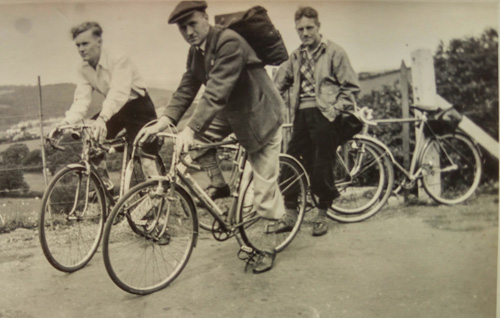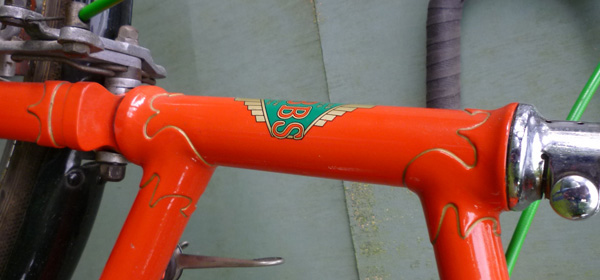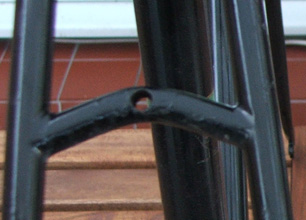Collier, Jim
Posted: Tuesday 02nd June 2020
James E Collier was born in September 1905 in Bermondsey South London. He was to become a very talented frame builder, firstly for Hobbs of Barbican in the 1930s and then for Gillott post war before becoming we believe a trade frame builder in the 1950s. He built some frames for Don Louis and in his twilight years worked for Witcomb in Deptford
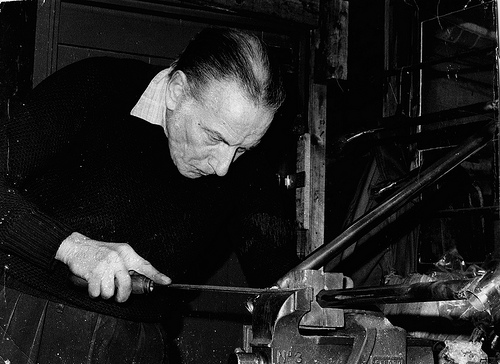
However, tragedy struck when he was aged twelve. His son Dennis takes up the story; ‘told me when his own dad died when he was 12 years old he got a job as a washer up in the Savoy Hotel, he wore his dads old coat and trousers and walked there from Jamaica Road Bermondsey and back every day and night, while clearing the dishes of the rich people who used the Savoy he would put half eaten meat and chops in his pockets along with anything edible like bones and potatoes and when he got home with scalded hands his mum would empty his pockets of all the food and put it in a huge pot with some water and pearl barley and leave it to cook and he and his seven brothers and sisters would have hot broth for a few days; he had a very hard life and rarely spoke about the hardships his family went through’.
By the mid 1930s things must have improved as he had become a frame builder for Hobbs of Barbican who along with Claud Butler were making some the finest bicycle frames of the pre war era with the ‘Continental’ very much ahead of its time. Gary, Jim’s Grandson has sent me a picture of Jim with his club mates all riding Hobbs of course and two bicycle passports for France and Italy in 1939 for a continental tour made immediately before the outbreak of World War II.
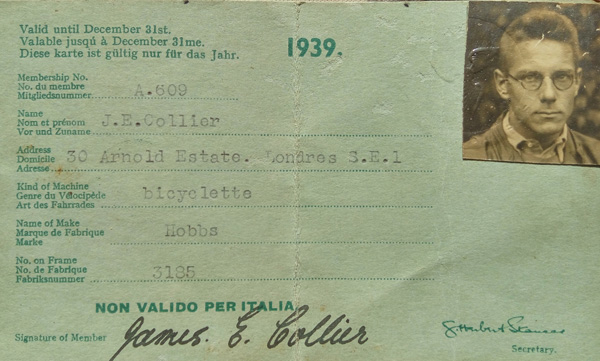
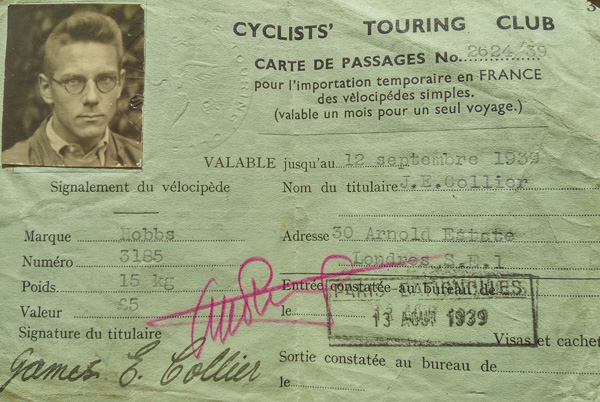
The address on these passports is worth a mention as the Arnold Estate was one of the first model housing developments which replaced the terrible slums that were a feature of Bermondsey at this time. The frame number on the passport is numerically very high and no Hobbs has survived with a frame number much beyond the 2000 mark for the pre war period according to the VCC records.Jim was put on essential war work at Woolwich Arsenal and the premises that Hobbs occupied in the Barbican were destroyed during the blitz in 1940. They re-emerged after the war at Sterling Works Dagenham but Jim did not return.
Jim’s abilities as a frame builder must have been well known as he was sought out by Harry Carrington of A S Gillott and released from war work prematurely to help revitalise the firm who were to become one of the finest frame makers in the country in the 40s and 50s. Harry assembled a formidable team which included the talents of Bill Philbrook. Gary says that Jim and Bill Philbrook were responsible for training Ron Cooper. However, there must been some dissent in the ranks as according to Mark Stevens Bill was caught by Harry making ’homers’ at Don Louis bike shop. Mark told me Harry inferred that Jim was pretty grumpy most of time. My own take on this was that although Harry’s attention to detail meant quality was maintained, I suspect that his employees were just not making enough money.
Dennis has an interesting anecdote to support this: ‘I remember we used to get a delivery from a huge furniture van of wheel rims wrapped in brown crepe paper to protect them along with packs of spokes and spoke nipples and boxes and boxes of hubs, we couldn’t use the front room as that’s where dad made up the wheels and put them on a blue wheel truer. By the end of the week you couldn’t move for made up wheels which were picked up by the same van and transported to “claude buttler” (sic), this was yet another way of bringing in some extra money as he had 5 children to feed, he was no shirker.’
Dennis’s memories extend to Jim’s other activities. ‘Dad used to be Reg Harris’s mechanic and I met Reg Harris many times as a youngster and watched my Dad support the bike by his saddle and push him off the start line’.
It is not known when Jim left A S Gillott. My gut feeling is around the very early 1950s. I think the climate at that time to start up on one’s own was rosy, but this was to quickly change. When I first became interested in the history of Youngs of Lewisham, Ernie Young told me that they employed Jim to provide them with their first hand built frames sold under their own name. I acquired one of these early frames from Ray Young that was in original condition which I thought dated from around 1953 from frame number. It was very light, built to an established formula using Nervex Pro lugs, Ekla fork crown, 72 degs parallel and 41” wheel base. One distinguishing factor stood out and that was an angled back brake bridge. It was the fashion in those days to have arched brake bridges of varying curves but it was clear that Jim didn’t have a bending machine necessary so created a simple angle instead. I have not seen this on any other maker’s frames.
I also found to my astonishment that I owned a Williamson Brothers of Holloway frame built in 1955 that was almost identical the Youngs but with a different metal head badge. Both are built in Reynolds 531 butted tubing but requiring a seat post size of 26.8mm and not the usual 27.2mm that most 531 butted tubing has. Since then I have seen a number frames of this type under different trade names including Hobbs but one cannot assume that all frames he made at this time had this feature. I was also told that Jim built frames for A. F. Mills of Welling. The ones I own are light and ride exceptionally well. However, the question remains: where were they built? Youngs early shop was too small to accommodate a frame builder and I never heard mention of a frame builder on the premises. In 1956 Youngs turned to Hinds and Green in Hendon to make their frames.
They had gained a good reputation and were building a great many frames for the trade by 1955. One can only speculate that this was around the time Jim largely gave up frame building to work for the Post Office in Dulwich. Dennis tells us that he did make some frames for Don Louis 1960s. This was not the end however, as Jim found his way to Witcomb in his twilight years initially carrying out menial tasks until they realised who he was and quickly put him back working where he belonged building quality bike frames. Dennis says that ‘his own father was a blacksmith and my dad preferred to use a fire rather than a torch’ if he could.
When he passed away at 87 we took his ashes to Herne Hill racetrack and scattered his ashes around the furthest point from the grand stand’
My thanks to Dennis and Gary Collier for providing information and impetus for this short article.
Bryan Clarke
October 2016
Posted: Tuesday 02nd June 2020
This article appears in the following categories.
Upcoming Events
Whether you are looking for a gentle social meet up, or a 100-mile ride browse the community’s upcoming events and plan your next weekend outing.

